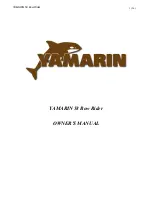
1
Introduction
The users of the boat are informed of the following:
This user guide/owner's manual is not a maintenance or repair guide. In case
of difficulty do not hesitate to call on the services of your
concessionnaire BE NE TE AU.
Any alterations which may affect the safety specifications of the boat must
be assessed, carried out and recorded by persons qualified to do so. Any change
in the distribution of the vessel's mass (adding a radar, altering the mast, changing
an engine, etc) may affect the stability, trim and performance of your boat.
The BENETEAU shipyards may not be held responsible for any alterations
which they have not approved.
The complete crew must be equipped appropriately.
In numerous countries, a licence, an authorization or a training course is
requested. Make sure you have this legal authorization before you use your boat.
Adapt the use of your boat to her condition that wears out with time and use.
Any boat, however solid she may be, may be severely damaged if badly used.
This is not compatible with a secure navigation. Always adapt the speed and
direction of your boat to the conditions of the sea.
The boat shall not be loaded more with than the maximum load
recommended by the builder, in particular the total weight of the food supplies,
of the different equipment that are not supplied by the builder and of the persons
on board.
The weight of the boat shall be properly distributed.
The stability is reduced when you add weight in the upper parts.
In case of heavy weather, the hatches, lockers and doors shall be closed in order to
minimize the risk of water coming in.
Breakers are serious dangers to stability.
The water in the bilge shall be kept at its minimum.
The stability may be reduced when you tow a boat or when you lift heavy weights
with the davits or the boom.
If your boat is equipped with a liferaft, carefully read the instructions. The boat
must have on board all the proper safety equipment (lifejackets, buoys, harness, flares,
liferafts, etc.) depending on the type of vessel, its cerfication, the country, the weather
conditions encountered, etc.
The crew must be familiar with the use of all the safety equipment and the
emergency safety procedures (MOB, towing etc.). Sailing schools organise regular
training sessions.
Anyone on the deck shall wear a life jacket or a buoyancy aid.
The safety regulations as defined by the sailing code and enforced by the ’’COLREG’’
should be observed.
Summary of Contents for FIRST 35
Page 1: ...FIRST 35 Code 091962 Owner s Manual ...
Page 2: ......
Page 4: ......
Page 7: ...3 Introduction HISTORY OF UPDATES Index A 08 2009 ...
Page 8: ......
Page 10: ......
Page 11: ...7 General specifications Technical specifications Certification Design category Your boat 1 ...
Page 26: ...22 Safety Use of the manual bilge pump Lay out of Operation ...
Page 28: ...24 Safety Acces to sector ...
Page 30: ......
Page 31: ...27 Hull Maintenance of the Hull Carreening 3 ...
Page 32: ...28 Hull Carreening Wetted area 27 5 m ...
Page 34: ......
Page 42: ......
Page 44: ......
Page 45: ...41 Steering system Steering Gear 5 ...
Page 46: ...42 Steering system Steering Gear ...
Page 47: ...Steering system 5 43 Detail B Detail C Detail D ...
Page 51: ...47 Rigging and Sails Standing rigging Running rigging Winches Sail setting Sails 6 ...
Page 52: ...48 Rigging and Sails Rigging Cruising DWL 1 2 3 4 5 ...
Page 54: ...50 Rigging and Sails Rigging Racing carbon DWL DWL 1 2 3 DWL 4 5 ...
Page 67: ...63 Fittings Introduction Interior maintenance Maintenance of fabrics 7 ...
Page 68: ...64 Fittings INTRODUCTION Fittings ...
Page 72: ......
Page 73: ...69 Water and sewage water Water tank Water system Distribution Water system Drainage Sewage 8 ...
Page 78: ......
Page 84: ......
Page 85: ...81 Electrical equipment General information 12 V DC system 110 220 VAC system Equipment 9 ...
Page 86: ...82 Electrical equipment Schematic diagram 12V T 30 ma 40A 220 Volts 50Hz ...
Page 98: ...94 Electrical equipment Electronics Transducer location View interior View Outside ...
Page 100: ......
Page 101: ...97 Engine General information Engine fitting 10 10 ...
Page 102: ...98 Engine Fuel tank Fuel filler Gauge Electrical panel Refer to the instructions for use ...
Page 104: ...100 Engine ENGINE FITTING ...
Page 105: ...101 Engine 10 10 ...
Page 106: ...102 Engine ...
Page 115: ...111 Launching Launching recommendations Stepping the mast 11 11 ...
Page 116: ...112 Launching POSITION OF HOISTING CRADLE AND STRAPS ...
Page 119: ...115 Winter Storage Laying up Protection and maintenance 12 12 ...
Page 120: ......
Page 122: ......






































